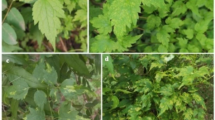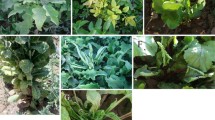Abstract
Over 4,950 asymptomatic weed samples from more than 20 weed species that are host plants for curtoviruses were collected from ten chile pepper fields in southern New Mexico (NM) during 2003, 2004 and 2005 to identify whether they were infected with curtoviruses and to determine which curtoviruses were distributed in the weed population. Polymerase chain reaction using primers designed to detect a portion of the coat protein (cp) gene were used to detect curtoviruses, and infected plants were further tested for specific curtoviruses using primers designed to detect to a portion of the replication-associated protein (rep) gene. Amplification of the cp gene was successful from 3.7, 1.17, and 1.9% of the weed samples in 2003, 2004, and 2005, respectively. Seventy-three amplicons from those samples were sequenced and compared to well-characterized curtoviruses. Analysis of the rep nucleotide sequences showed that ~32.9% of the weed isolates tested were closely related to beet mild curly top virus (BMCTV). Approximately 12.4% were closely related to beet severe curly top virus (BSCTV). The rest of the weed isolates (54.7%), which shared a very high level of nucleotide sequence identity to each other, represent a new curtovirus species. Using eight primers designed for PCR, complete genomes of three curtoviruses isolated from chile pepper samples representing the three groups of curtoviruses in southern New Mexico were sequenced. Comparisons of whole sequences of the genomes revealed that the DG2SW171601 isolate (2,929 nucleotides) was nearly identical to BMCTV-W4 (~98% nucleotide sequence identity). The LRME27601 isolate (2,927 nucleotides) was most closely related to BSCTV (~92% nucleotide sequence identity). The LJN17601 isolate (2,959 nucleotides) shared only from 49.9 to 88.8% nucleotide sequence identity with other well-characterized curtoviruses. Based on the accepted cut-off of 89%, we propose that the LJN17601 isolate is a member of a new curtovirus species. Chile peppers infected with this virus in the field express chlorotic stunting symptoms, so we propose the name pepper yellow dwarf virus (PeYDV). This new curtovirus species may be the result of mutations in the genome and recombination between BMCTV-W4 and BSCTV.



Similar content being viewed by others
References
Baliji S, Black MC, French R, Stenger DC, Sunter G (2004) Spinach curly top virus: a newly described curtovirus species from southwest Texas with incongruent gene phylogenies. Phytopathology 94:772–779
Baliji S, Sunter J, Sunter G (2007) Transcriptional analysis of complementary sense genes in Spinach curly top virus and functional role of C2 in pathogenesis. Mol Plant Microbe Interact 20:194–206
Bao Y, Kapustin Y, Tatusova T (2008) Virus classification by pairwise sequence comparison (PASC), vol 5. In: Mahy BWJ, Van Regenmortel MHV (eds) Encyclopedia of virology, 5 vols. Elsevier, Oxford, pp 342–348
Bennett CW (1971) The curly top disease of sugarbeet and other plants. Monograph 7. The American Phytopathological Society, St. Paul
Briddon RW, Pinner MS, Stanley J, Markham PG (1990) Geminivirus coat protein gene replacement alters insect specificity. Virology 177:84–94
CABI and EPPO. Beet curly top hybrigeminivirus. Data sheets on quarantine pests Available via DIALOG. http://www.eppo.org/QUARANTINE/virus/Beet_curly_top_curtovirus/BCTV00_ds.pdf
Cook WC (1967) Life history, host plants, and migrations of the beet leafhopper in the western United States. USDA Tech Bull 1365:122
Crawford RF (1927) Curly top in New Mexico. USDA Off Rec 6:8
Creamer R, Carpenter J, Rascon J (2003) Incidence of the Beet Leafhopper, Circulifer tenellus (Homoptera:Cicadellidae), in New Mexico Chile. New Mexico Chile Task Force. Report 12. Available via DIALOG. http://www.chiletaskforce.org and http://www.cahe.nmsu.edu/pubs/research/
Creamer R, Hubble H, Lewis A (2005) Curtovirus infection of chile pepper in New Mexico. Plant Dis 89:480–486
Dellaporta S, Wood L, Hicks JB (1983) A plant DNA minipreparation: version II. Plant Mol Biol Report 1(14):19–21
Fauquet CM, Stanley J (2003) Geminivirus classification and nomenclature: progress and problems. Ann Appl Biol 142:165–189
Fauquet CM, Briddon RW, Brown JK, Moriones E, Stanley J, Zerbini M, Zhou X (2008) Geminivirus strain demarcation and nomenclature. Arch Virol 153:783–821
Goldberg NP (1999) Curly top devastates chile crop. Plant Science News. New Mexico State University, Cooperative Extension Service. Las Cruces, 8 p
Goldberg NP (2001) Chile pepper disease. New Mexico State University, Cooperative Extension Circular 549. Las Cruces, 17 pp
Hormuzdi SG, Bisaro DM (1993) Genetic analysis of Beet curly top virus: evidence for three virion sense genes involved in movement and regulation of single and double stranded DNA levels. Virology 193:900–909
Hormuzdi SG, Bisaro DM (1995) Genetic analysis of Beet curly top virus: examination of roles of L2 and L3 genes in viral pathogenesis. Virology 206:1044–1054
Hull R (2002) Matthews’ plant virology. Academic Press, San Diego, 1001 pp
Khan JA, Dijkstra JE (2002) Plant viruses as molecular pathogens. Food Products Press, New York, 537 pp
Klute KA, Nadler SA, Stenger DC (1996) Horseradish curly top virus is a distinct subgroup II geminivirus species with rep and C4 genes derived from a subgroup III ancestor. J Gen Virol 77:1369–1378
Martin DP, Williamson C, Posada D (2005) RDP2: recombination detection and analysis from sequence alignments. Bioinformatics 21:260–262
New Mexico Agricultural Statistics (2000) USDA. NM Ag Stats Service, Las Cruces
Stanley J, Markham PG, Callis RJ, Pinner MS (1986) The nucleotide sequence of an infectious clone of the geminivirus Beet curly top virus. EMBO J 5:1761–1767
Stenger DC, McMahon CL (1997) Genetic diversity of Beet curly top virus populations in the western United States. Phytopathology 87:737–744
Stenger DC (1998) Replication specificity elements of the Worland strain of Beet curly top virus are compatible with those of the CFH strain but not those of the Cal/Logan strain. Phytopathology 88:1174–1178
Stenger DC, Revington GN, Stevenson MC, Bisaro DC (1991) Replicational release of geminivirus genomes from tandemly repeated copies: Evidence for rolling-circle replication of a plant viral DNA. Proc Nadl Acad Sci USA 88:8029–8033
Stenger DC, Carbonaro D, Duffus JE (1990) Genomic characterization of phenotypic variants of Beet curly top virus. J Gen Virol 71:2211–2215
Stenger DC, Davis KR, Bisaro DM (1994) Recombinant Beet curly top virus genomes exhibit both parental and novel pathogenic phenotypes. Virology 200:677–685
Strausbaugh CA, Wintermantel WM, Gillen AM, Eujayl IA (2008) Curly Top Survey in the Western United States. Phytopathology 98:1212–1217
Yazdi HR, Heydarnejad J, Massumi H (2008) Genome characterization and genetic diversity of Beet curly top Iran virus: a geminivirus with a novel nonanucleotide. Virus genes 36:539–545
Acknowledgments
We thank the New Mexico State University Agricultural Experiment Station for supporting this work.
Author information
Authors and Affiliations
Corresponding author
Rights and permissions
About this article
Cite this article
Lam, N., Creamer, R., Rascon, J. et al. Characterization of a new curtovirus, pepper yellow dwarf virus, from chile pepper and distribution in weed hosts in New Mexico. Arch Virol 154, 429–436 (2009). https://doi.org/10.1007/s00705-009-0320-1
Received:
Accepted:
Published:
Issue Date:
DOI: https://doi.org/10.1007/s00705-009-0320-1




